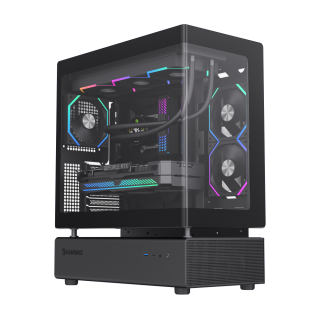When building or upgrading a personal computer, one of the critical components to consider is the PC case. Often overlooked, the case is not merely a shell; it plays a vital role in the system’s cooling, aesthetics, and overall functionality. One question many builders have is whether PC cases come with fans. This article delves into this topic, exploring the various types of fans, the importance of airflow, and what to look for when selecting a PC case.
PC case fans are essential for maintaining optimal temperatures within the computer. They facilitate airflow, which helps dissipate heat generated by components like the CPU, GPU, and power supply. Proper cooling is crucial for system stability, performance, and longevity.

The short answer is yes, but the specifics can vary widely. Many mid-tower and full-tower cases come with pre-installed fans, while smaller or budget models might not include any. Here’s a breakdown:
Standard Features: Most standard cases come equipped with at least one or two fans. Typically, there will be a rear exhaust fan and possibly one or two front intake fans.
Fan Quality: The quality of pre-installed fans can vary. While some cases offer decent quality fans, others might include lower-quality options that may not provide sufficient cooling.
When considering a PC case, it's essential to understand the various fan configurations available:
Pre-Installed Fans: Many manufacturers provide basic configurations, such as a rear 120mm fan for exhaust and front slots for additional fans. Some higher-end cases might include RGB fans for aesthetics.
Fan Mounting Points: Look for cases that have multiple mounting points for fans. This allows for customization based on your cooling needs, whether for air or liquid cooling solutions.
Compatibility with Aftermarket Fans: If you prefer more efficient or aesthetically pleasing fans, ensure the case supports aftermarket fan installations. Compatibility with different fan sizes (like 120mm, 140mm, or even larger) is crucial.
There are various types of fans to consider:
Static Pressure Fans: These are designed to push air through tight spaces, making them ideal for use on heatsinks and radiators.
Airflow Fans: Designed for moving air efficiently within a case, these fans excel at creating airflow pathways.
RGB Fans: For those who want aesthetics to match performance, RGB fans offer customizable lighting options, enhancing the visual appeal of a PC build.

• Detachable modular design
• Integrated wraparound glass panel
• Internal panorama view
• 270° cooling with 6 ARGB fans
• Customizable ARGB sync
• Vertical GPU mount
When discussing fans, it’s essential to consider the broader context of cooling solutions available within a PC case:
Air Cooling: Most standard cases support air cooling through various fans. It’s the most common and generally the most cost-effective cooling method.
Liquid Cooling: Many cases now support liquid cooling solutions, often providing mounting points for radiators. This can include configurations for 120mm, 240mm, or even larger radiators, depending on the case size.
When selecting a PC case, consider the following factors regarding fans:
Included Fans: Check how many fans come pre-installed and their sizes. This can significantly affect your cooling strategy.
Expansion Options: Ensure the case allows for future fan expansions. You may need additional cooling as you upgrade components.
Noise Levels: Look for cases with fans that operate quietly. Noise levels can vary, and quieter fans can lead to a more pleasant computing environment.
Design and Aesthetics: If you’re going for a specific look, consider cases with RGB lighting or those that allow for unique fan placements.
In summary, many PC cases come equipped with fans, but the number, quality, and configuration can differ significantly between models. When building or upgrading a PC, understanding the role of these fans and how they impact overall system performance is vital. Whether you opt for pre-installed fans or decide to invest in higher-quality aftermarket options, ensuring your system has adequate cooling will contribute to its efficiency, longevity, and performance.